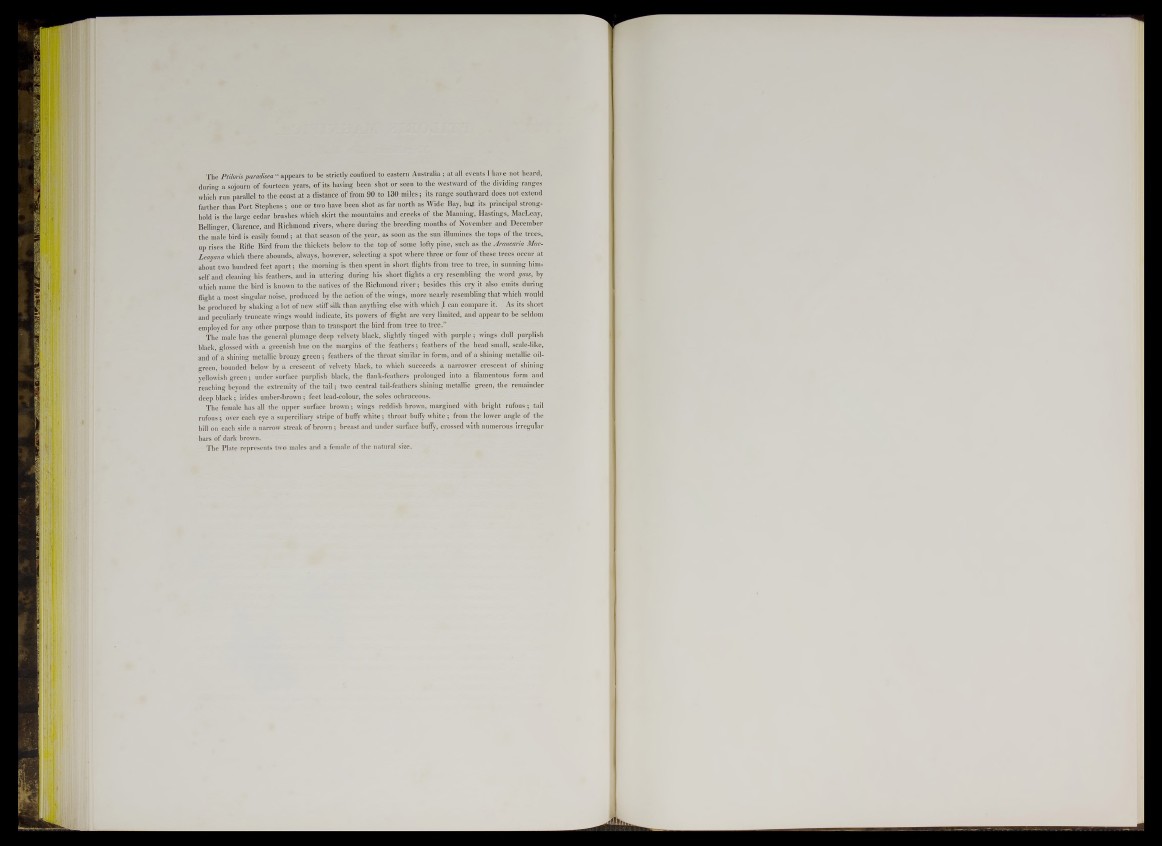
The Ptiloris paradisea “ appears to be strictly confined to eastern Australia; at all events I have not heard,
during a sojourn of fourteen years, of its having been shot or seen to the westward of the dividing ranges
which run parallel to the coast at a distance of from 90 to 130 miles; its range southward does not extend
farther than Port Stephens; one or two have been shot as far north as Wide Bay, but its principal stronghold
is the laro-e cedar brushes which skirt the mountains and creeks of the Manning, Hastings, MacLeay,
Bellinger, Clarence, and Richmond rivers, where during the breeding months of November and December
the male bird is easily found; at that season of the year, as soon as the sun illumines the tops of the trees,
up rises the Rifle Bird from the thickets below to the top of some lofty pine, such as the Araucaria Mac-
Leayana which there abounds, always, however, selecting a spot where three or four of these trees occur at
about two hundred feet ap a rt; the morning is then spent in short flights from tree to tree, in sunning himself
and cleaning his feathers, and in uttering during his short flights a cry resembling the word pass, by
which name the bird is known to the natives of the Richmond river; besides this cry it also emits during
flight a most singular noise, produced by the action of the wings, more nearly resembling that which would
be. produced by shaking a lot of new stiflf silk than anything else with which ,1 can compare it. As its short
and peculiarly truncate wings would indicate, its powers of flight are very limited, and appear to be seldom
employed for any other purpose than to transport the bird from tree to tree.”
The male has the general plumage deep velvety black, slightly tinged with purple; wings dull purplish
black, idossed with a greenish hue on the margins of the feathers; feathers of the head small, scale-like,
and of a shining metallic bronzy green ; feathers of the throat similar in form, and of a shining metallic oil-
green, bounded below by a crescent of velvety black, to which succeeds a narrower crescent of shining
yellowish gre en; under surface purplish black, the flank-feathers prolonged into a filamentous form and
reaching beyond the extremity of the tail; two central tail-feathers shining metallic green, the remainder
deep black; irides umber-brown ; feet lead-colour, the soles ochraceons.
The female has all the upper surface brown; wings reddish brown, margined with bright rufous; tail
rufous- over each eye a superciliary stripe of huffy white; throat huffy white ; from the lower angle of the
bill on each side a narrow streak of brown ; breast and under surface huffy, crossed with numerous irregular
bars of dark brown.
The Plate represents two males and a female of the natural size.